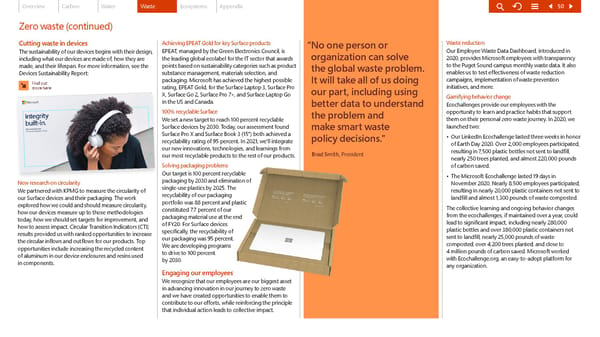Overview Carbon Water Waste Ecosystems Appendix 50 Zero waste (continued) Cutting waste in devices Achieving EPEAT Gold for key Surface products “ No one person or Waste reduction The sustainability of our devices begins with their design, EPEAT, managed by the Green Electronics Council, is Our Employee Waste Data Dashboard, introduced in including what our devices are made of, how they are the leading global ecolabel for the IT sector that awards organization can solve 2020, provides Microsoft employees with transparency made, and their lifespan. For more information, see the points based on sustainability categories such as product the global waste problem. to the Puget Sound campus monthly waste data. It also Devices Sustainability Report: substance management, materials selection, and enables us to test effectiveness of waste reduction Find out packaging. Microsoft has achieved the highest possible It will take all of us doing campaigns, implementation of waste prevention more here rating, EPEAT Gold, for the Surface Laptop 3, Surface Pro our part, including using initiatives, and more. X, Surface Go 2, Surface Pro 7+, and Surface Laptop Go Gamifying behavior change in the US and Canada. better data to understand Ecochallenges provide our employees with the 100% recyclable Surface the problem and opportunity to learn and practice habits that support We set a new target to reach 100 percent recyclable them on their personal zero waste journey. In 2020, we Surface devices by 2030. Today, our assessment found make smart waste launched two: Surface Pro X and Surface Book 3 (15”) both achieved a policy decisions.” • Our LinkedIn Ecochallenge lasted three weeks in honor recyclability rating of 95 percent. In 2021, we’ll integrate of Earth Day 2020. Over 2,000 employees participated, our new innovations, technologies, and learnings from resulting in 7,500 plastic bottles not sent to landfill, our most recyclable products to the rest of our products. Brad Smith, President nearly 250 trees planted, and almost 220,000 pounds Solving packaging problems of carbon saved. Our target is 100 percent recyclable • The Microsoft Ecochallenge lasted 19 days in New research on circularity packaging by 2030 and elimination of November 2020. Nearly 8,500 employees participated, We partnered with KPMG to measure the circularity of single-use plastics by 2025. The resulting in nearly 20,000 plastic containers not sent to our Surface devices and their packaging. The work recyclability of our packaging landfill and almost 1,300 pounds of waste composted. explored how we could and should measure circularity, portfolio was 88 percent and plastic how our devices measure up to those methodologies constituted 7.7 percent of our The collective learning and ongoing behavior changes today, how we should set targets for improvement, and packaging material use at the end from the ecochallenges, if maintained over a year, could how to assess impact. Circular Transition Indicators (CTI) of FY20. For Surface devices lead to significant impact, including nearly 280,000 results provided us with ranked opportunities to increase specifically, the recyclability of plastic bottles and over 380,000 plastic containers not the circular inflows and outflows for our products. Top our packaging was 95 percent. sent to landfill, nearly 25,000 pounds of waste opportunities include increasing the recycled content We are developing programs composted, over 4,200 trees planted, and close to of aluminum in our device enclosures and resins used to drive to 100 percent 4 million pounds of carbon saved. Microsoft worked in components. by 2030. with Ecochallenge.org, an easy-to-adopt platform for any organization. Engaging our employees We recognize that our employees are our biggest asset in advancing innovation in our journey to zero waste and we have created opportunities to enable them to contribute to our efforts, while reinforcing the principle that individual action leads to collective impact.
 Microsoft Environmental Sustainability Report 2020 Page 49 Page 51
Microsoft Environmental Sustainability Report 2020 Page 49 Page 51